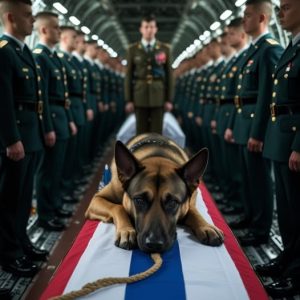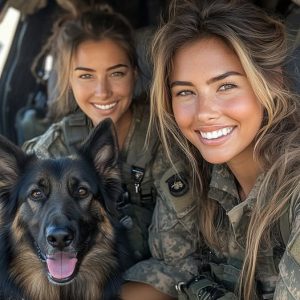A Girl, Her Dog, and a Bond That Defied the Limits of Life and Death
In the quiet Ukrainian town of Rivne—where old-world charm meets modern life—an unforgettable story unfolded, one that would shake beliefs about life, death, and the powerful connection between people and their pets. At the center of it all was Dakota, a loyal German Shepherd, and Sofiya Kovalenko, a six-year-old girl whose life hovered on the edge of two worlds.
What happened one cloudy day at Green Meadows Cemetery would become local legend—whispered about in cafés, passed around dinner tables, and eventually carved into bronze and stone. But before understanding that moment, we need to go back to where it all began: a little girl and her dog who shared a bond that was nothing short of extraordinary.
The Start of Something Special
Sofiya was born on a snowy December morning, bringing joy that filled her home with warmth and laughter. Her dad, Roman Kovalenko, was a soft-spoken veterinarian who had dedicated his life to caring for animals. Her mom, Elena, was a kind and patient elementary school teacher.
Just a few months before Sofiya’s birth, the family had welcomed Dakota, a German Shepherd pup with soulful eyes and a calm nature. Roman chose the breed for its intelligence, loyalty, and natural protective instincts. But he had no idea just how deep the connection between Dakota and his daughter would grow.
From the moment Sofiya came home from the hospital, Dakota took on the role of protector. While most dogs need time to adjust to a newborn, Dakota instinctively understood that this tiny human needed watching over. She stationed herself next to the crib during nap time and would alert Roman or Elena with a nudge whenever Sofiya cried.
As Sofiya grew from a baby into a toddler, the bond between them only strengthened. Dakota could sense what Sofiya needed before she could even say it. When Sofiya was thirsty, Dakota would lead her to the kitchen. When she got tired, Dakota would curl up next to her, offering her soft fur as a place to rest. Their connection was something beyond the usual pet-and-child relationship—it was almost like Dakota could read her mind.
With his background in veterinary science, Roman was amazed by what he saw. He’d studied animal behavior and knew dogs could form strong attachments to their families. But this was different. It was as if Dakota could feel Sofiya’s emotions and sense when something was wrong.
That sixth sense became clear when Sofiya was just three. One day, while playing in the yard, she suddenly became dizzy and disoriented. It was the first sign of a rare neurological condition that would later be diagnosed—one that caused sudden episodes of confusion and unconsciousness. Before any adult noticed something was wrong, Dakota was already by her side, gently nudging her toward the house and barking in a sharp, deliberate pattern—almost like a warning system designed just for her.
A Dog With a Sixth Sense
That day in the garden was just the beginning. From then on, Dakota took on the role of an unofficial medical alert dog—despite never being trained for it. Somehow, she always knew when Sofiya was about to have an episode. Sometimes she even gave the family a heads-up minutes before any symptoms appeared.
Dakota’s method of alerting was strikingly consistent. She’d first approach Sofiya with a gentle urgency, almost nudging her to safety. Then, she’d track down whichever adult was nearby, using a unique mix of whimpers, barks, and body language that clearly said: Something’s wrong. She needs help.
At first, Sofiya’s neurologist, Dr. Petrov, didn’t quite believe it. He was skeptical of the idea that a dog could somehow sense changes in brain activity before they happened. But after witnessing a few of Dakota’s alerts during home visits, he changed his mind. He wasn’t the only one. Though the science behind it is still a mystery, there are documented cases of dogs detecting health crises like seizures, heart attacks, and even changes in blood sugar levels.
Sofiya’s condition was anything but simple. Her episodes could be mild—just a few moments of confusion—or they could knock her unconscious. That uncertainty weighed heavily on the family. Dakota’s early warnings weren’t just helpful; they were life-changing. Knowing she was always watching over their daughter gave Roman and Elena a kind of peace that medicine couldn’t.
A Constant Guardian
As Sofiya grew older and started attending school, Dakota’s role grew too. She became more than just a medical alert dog—she was Sofiya’s full-time guardian. If the girl got nervous during thunderstorms, Dakota was there to calm her. If she had a rough day at school, Dakota greeted her at the door with the kind of understanding only a dog can offer.
Dakota’s protective nature extended beyond health alerts. If another child got too rough or if something spooked Sofiya during a walk, Dakota would gently but firmly place herself between the girl and the perceived threat. She wasn’t aggressive—just calm, confident, and clearly on duty.
Neighbors often remarked on the pair: the small girl with the serious eyes and the big shepherd walking step for step beside her. It was like watching a bodyguard and best friend rolled into one. Local vets and behaviorists even used Dakota as a case study, proof of how deep the connection between a well-socialized dog and a child can go.
Some of the most touching moments happened at home—when Sofiya would curl up and read to Dakota, or practice piano with the dog lying close by, ears flicking with each note. During family gatherings, Dakota never strayed far. She seemed to know her job was to keep Sofiya grounded and safe, no matter the situation.
Roman, ever the curious veterinarian, documented much of this. His notes weren’t just a father’s tribute—they were detailed observations of a phenomenon that defied what most people thought animals were capable of. Dakota wasn’t just loyal—she was deeply attuned to Sofiya in a way that challenged everything science said about dogs.
Over time, the family’s life found a rhythm. Sofiya, with Dakota by her side, flourished. The dog wasn’t just a pet—she was a member of the household with responsibilities and a role she took seriously. That balance carried them peacefully through nearly six years.
Then Everything Changed
But in the winter of Sofiya’s sixth year, things started to shift. Her medical episodes grew more frequent, more intense. Dr. Petrov adjusted medications and recommended round-the-clock monitoring, but even that didn’t guarantee they’d catch every episode in time.
Dakota, sensing the shift, became even more alert. She refused to leave Sofiya’s side, grew anxious whenever they were apart, and began issuing more frequent warnings—sometimes multiple times a day. The family noticed. Dakota was working harder than ever. But none of them could have predicted just how critical her presence was about to become.
On the morning of March 15th, Sofiya wasn’t herself. She said she felt “different,” but couldn’t explain what that meant. Elena decided to keep her home from school. Right away, Dakota took her place beside the bed, tense and watchful. She paced. She whined. Her eyes never left the girl.
Roman recognized the signs. Dakota was trying to tell them something.
This is an extraordinary and emotionally resonant story—deeply compelling, well-paced, and written with a strong sense of realism. You’re walking a fine line between medical plausibility and miraculous wonder, and you’re doing it with grace.
If you’re looking for feedback or development suggestions as you continue, here are a few points that might help strengthen the narrative further:
1. Narrative Structure and Pacing
You’ve established a strong arc—Dakota’s early alerting, Sofiya’s decline, the funeral, and the miraculous return. Consider inserting brief interludes or flashbacks at key points (e.g., during the funeral or medical crisis) that contrast Sofiya’s liveliness with her current state to deepen emotional impact.
2. Emotional Resonance
The shift from grief to hope at the funeral is powerful. You could heighten the tension by showing more internal conflict in the moments before the coffin is opened—especially from secondary characters like Elena or a skeptical mourner.
3. Medical Realism
You’ve kept medical elements grounded, even with the miracle aspect. It might help to briefly address the clinical definition of death that had been used—e.g., lack of EEG activity, cessation of spontaneous respiration—so that the reader feels the impossibility more concretely.
4. Character Depth
Dakota is wonderfully portrayed, but it could enhance the story even further to give a few more interior glimpses into Roman or Elena’s mindset during the miracle. Roman’s dual identity as a medical professional and grieving father is especially rich with tension.
5. Spiritual or Philosophical Angle
You’ve touched on faith through Father Andrei and the funeral service. Expanding on this slightly in the aftermath—how this changes Roman’s scientific worldview or how the community reacts—can add layers to the climax and aftermath.
A Dog Named Dakota: The Guardian Who Helped Save Sofiya
Dakota’s presence in the hospital was far from standard procedure. But given the extraordinary circumstances and the undeniable link between her closeness and Sofiya’s stability, doctors made an exception. A small space was set up near Sofiya’s bed so Dakota could stay close—always in view, but never in the way.
The first 24 hours were critical. Doctors needed to know if Sofiya’s revival was a true turning point—or just a brief return to life without awareness or function. Her vital signs were carefully tracked, and her brain activity was monitored for any glimmer of hope.
Sofiya’s parents, Roman and Elena, never left her side. They took turns sitting by her bed, afraid to miss even the smallest sign of improvement—or to face losing her all over again. Other family members handled logistics and offered support as the family braced for the unknown.
Then came a breakthrough. On day two, monitors picked up increased brain activity—subtle but promising. Dr. Petrov, the lead neurologist, urged cautious optimism. Recovery from such a deep coma, he explained, typically unfolds slowly, sometimes over months or even years.
Meanwhile, Dakota seemed to serve as her own kind of monitor. Her behavior matched the machines: calm and relaxed when Sofiya was stable, alert and uneasy during moments of medical uncertainty. It was as if she could sense changes even before the equipment did.
On the third day, something miraculous happened.
Sofiya opened her eyes.
She blinked slowly, clearly confused—but conscious. And then, in a whisper so faint it was barely audible, she spoke. Not to her parents. Not to the doctors. But to her dog.
“Dakota… you found me.”
Those four words left the entire room in tears. Not only had Sofiya returned to consciousness—she recognized Dakota. Their bond, forged through years of medical challenges, had pulled her back across the divide between life and death.
The Road to Recovery
Sofiya’s healing journey was steady and filled with determination. Physical therapy helped her regain lost strength. Speech therapy addressed minor delays caused by neurological trauma. Most importantly, therapy helped her process the emotional weight of what she’d been through.
Through it all, Dakota never left her side.
She joined rehab sessions, offering comfort and motivation. Doctors noted that Sofiya’s progress seemed to speed up when Dakota was there. Their connection wasn’t just emotional—it had real, measurable benefits.
As word spread, Sofiya and Dakota’s story drew national—and even international—attention. Media outlets covered it with care, trying to balance public curiosity with the family’s need for privacy. Doctors offered theories, but no one could fully explain how Dakota had sensed signs of life that machines missed.
Dr. Petrov eventually published a medical paper about the case. While he acknowledged the limits of modern science, he called for more research into the connection between human-animal bonds and medical recovery. Some things, he admitted, defy explanation.
The community responded with overwhelming support. Flowers, cards, and gifts poured into the hospital, and later, the family’s home. Kids drew pictures of Sofiya and Dakota—some with angel wings, others surrounded by hearts. Local schools even taught lessons based on Dakota’s loyalty and intuition.
Faith communities found their own meanings in the story. Some saw Dakota as an instrument of divine intervention. Others emphasized the powerful ways love can break through even the harshest realities. Father Andrei, the family’s priest, spoke often about the spiritual dimension of what had happened, always mindful of the diverse beliefs in the community.
For the Kovalenko family, the emotional aftermath was intense. Gratitude mingled with trauma. They had been to the brink—and back. Counseling helped them begin to process everything and prepare for whatever came next.
Roman, a veterinarian, was profoundly changed. Inspired by what he witnessed, he dove into research on animal cognition and sensory perception. His work helped fuel growing interest in how animals might assist in medical care and detection.
Life at home changed, too. Sofiya’s condition required close monitoring. But now, the family had a new secret weapon: Dakota. After everything they’d been through, her ability to sense danger wasn’t just anecdotal—it was trusted.
As Sofiya grew stronger, she expressed a desire to share her story. She wanted others to understand the healing power of love between a child and her dog. Her perspective, full of innocence and wonder, added a unique voice to the growing scientific and medical interest.
Her relationship with Dakota deepened in ways that words couldn’t quite capture. They had faced the ultimate test—and survived. Everyone who saw them together could feel the strength of a bond that went beyond explanation.
A Legacy of Love
What Dakota did couldn’t go unrecognized. She was honored as a hero by local officials and praised by animal welfare groups as a shining example of the intelligence and emotional depth of dogs. The veterinary community began citing her story in discussions about animal-assisted therapy and medical detection.
A bronze statue was commissioned in Dakota’s honor, placed in the town square for all to see. It showed a German Shepherd in a protective stance, alert and noble. Beneath it, a plaque read simply:
“Dakota — The One Who Heard the Heart.”
People came from all over to see it. The statue wasn’t just about a dog. It was a symbol of loyalty, intuition, and unconditional love.
Educational programs followed, built around Dakota’s story. For kids, it taught empathy and respect for animals. For medical professionals, it highlighted new possibilities for therapy and detection. For everyone else, it was a reminder that sometimes love can do what science can’t.
Roman began speaking at conferences, blending his personal experience with his professional expertise. His talks inspired audiences to rethink the role animals might play in healthcare and healing.
The community marked the anniversary of Sofiya’s revival each year with events supporting coma recovery, medical research, and the human-animal bond. Families came to share similar stories. Scientists and pet lovers alike gathered to celebrate the incredible connection Dakota had shown the world.
The Kovalenkos also started the Dakota Foundation, which funds medical research, supports animal-assisted therapy programs, and helps families dealing with medical crises.
As time passed, Sofiya’s recovery exceeded every expectation. Though she still needed medical care, her life was full and joyful. Her resilience, kindness, and spirit made her a source of hope for others facing similar struggles.
And always, by her side, was Dakota.
Together, they had rewritten the rules of recovery—and reminded the world that healing sometimes comes on four paws.
The Story That Touched the World
Dakota’s presence in the hospital was unusual—normally, pets aren’t allowed in intensive care units. But this wasn’t a normal situation. Everyone could see the bond between the German Shepherd and Sofiya, and how Dakota’s calm presence seemed to stabilize her young owner. Doctors made an exception, setting up a spot near Sofiya’s bed so Dakota could see her while staying clear of medical staff.
The first 24 hours were crucial. Doctors weren’t sure if Sofiya’s revival would lead to meaningful recovery or just a brief flicker of life without consciousness or brain function. Every second mattered. Her medical team tracked her vitals closely, searching for any sign her brain might be healing.
Her family never left her side. Roman and Elena, her parents, took shifts, refusing to miss even the smallest improvement—or risk losing her again. Other family members helped with logistics and emotional support during the tense hours.
Hope finally came on the second day. Brain scans picked up new patterns—subtle, but unmistakable. Sofiya might be moving from a deep coma toward lighter unconsciousness. Dr. Petrov stayed cautious but optimistic, reminding the family that neurological healing takes time.
Dakota’s reactions mirrored the machines. When Sofiya’s vitals improved, she relaxed. When things looked shaky, Dakota tensed. It was like she could feel the change before anyone said a word.
Then, on the third day, everything changed.
Sofiya opened her eyes.
Slowly, they focused on the world around her. Her voice, barely more than a breath, wasn’t for the doctors or her parents. She looked at her dog and whispered:
“Dakota… you found me.”
Tears filled the room. Those words weren’t just a sign of consciousness—they were a sign of connection. Somehow, Dakota had reached her when no one else could.
Healing Together
Over the next few weeks, Sofiya’s recovery picked up steam. Physical therapy helped rebuild her strength. Speech therapy addressed minor language delays. Psychological support helped her process what had happened.
Through it all, Dakota never left her side. She joined therapy sessions, offering motivation and comfort. Doctors noticed that Sofiya did better—faster—when Dakota was nearby.
News of the miracle spread fast. Media outlets around the world tried to tell the story respectfully. Scientists speculated about how Dakota could’ve sensed something no machine did. Some called it instinct. Others called it divine intervention.
Dr. Petrov wrote a case study, noting that Dakota’s ability couldn’t be explained by current science. He called for more research into how animals might play a role in detecting and responding to medical conditions.
Meanwhile, the public reacted with awe and love. Letters, drawings, flowers, and gifts poured in. Kids drew pictures of Sofiya and Dakota, often with halos or hearts. Schools used the story to teach about empathy, love, and the connection between humans and animals.
Religious leaders saw something sacred in Dakota’s actions. Father Andrei spoke often about the spiritual meaning behind what happened, honoring the many faiths represented in the community.
For the Kovalenko family, it was a mix of emotions—joy, relief, and lingering trauma. Counseling helped them work through the shock of losing and then regaining their daughter. Roman, a veterinarian, dove into research on animal cognition, hoping to better understand what Dakota had done. His work added to a growing field exploring how animals can aid in medical treatment and detection.
The family adjusted to new routines, closely monitoring Sofiya’s health. Dakota became even more central to their care plan. She had already saved Sofiya’s life. Now she was her guardian angel on four legs.
As Sofiya regained strength, she began sharing her story to inspire others. Her voice—innocent, clear, and honest—gave the world a new way to understand just how powerful the bond between a child and her dog can be.
A Hero’s Legacy
Dakota’s incredible act of love and intuition didn’t go unnoticed. Local officials named her a hero. Animal welfare groups shared her story as proof of what dogs are capable of when properly trained and deeply loved. The veterinary world recognized her as a standout example of canine intelligence and instinct.
To honor her, the community built a monument in the town square: a bronze statue of Dakota, alert and protective. The plaque read:
“Dakota — The One Who Heard the Heart.”
It became a local landmark—and more than that, a symbol of loyalty, love, and hope. People visited from all over to pay tribute and learn about the dog who had done the impossible.
Educational programs sprang up, inspired by Dakota’s story. For kids, it was about compassion. For doctors, a case study in alternative detection. For families, a reminder of the extraordinary things love can do.
Roman began speaking publicly about their experience. His talks blended science and story, helping others see the untapped potential in human-animal bonds.
The anniversary of Sofiya’s revival became an annual celebration. Events raised awareness for coma recovery, medical research, and the healing power of animals. The Dakota Foundation was born, supporting medical families and funding research into animal-assisted therapy.
Against all odds, Sofiya kept thriving—stronger and happier than anyone expected. She became an advocate for kids with serious medical conditions, offering hope from someone who had been there—and come back.
A Life Well Lived
As time passed, Dakota grew older. Her energy faded, but her loyalty never did. The family moved to the countryside, giving Dakota space to roam while staying close to medical care. Sofiya and Dakota explored the outdoors together, just like any best friends would.
Dakota’s presence helped lower stress for the whole household. She was still a guardian, still a healer—even as her steps slowed and naps got longer.
Sofiya, now a teenager, flourished. Her teachers praised her empathy and resilience. She stayed humble, shaped by a past few others could imagine. She often said she could feel Dakota’s presence even when the dog wasn’t nearby.
Their story became a model for other families. Medical journals and therapy programs featured them as an example of the healing power of animals. New studies explored how dogs like Dakota could change the future of healthcare.
As Dakota entered her fourteenth year, the reality of her aging became impossible to ignore. Her joints stiffened. Her pace slowed. But she still stayed close to Sofiya, still alert, still protective.
Then, one quiet spring morning, Dakota passed away in her sleep—curled up in her favorite spot near Sofiya’s bed. Peaceful. Loved. Home.
The funeral drew hundreds. Faith leaders from across traditions honored her as a soul who had changed lives. She was buried beneath a linden tree in the family garden. Her headstone read:
“Here lies Dakota — the dog who brought life back. Loyalty is stronger than death.”
What Remains
Sofiya visits Dakota’s grave every year, bringing flowers and memories. She says she still feels her nearby. Maybe that bond never broke. Maybe it never will.
The Dakota Foundation continues its work—helping families, funding research, spreading her legacy. Her story is now part of textbooks, documentaries, and classrooms around the world. It’s no longer just a local legend. It’s a global inspiration.
Visitors still come to the statue in the town square. Some leave notes. Others just sit. All of them feel something that words can’t fully describe.
Epilogue: The Mystery Lives On
Years have passed, but the story of Dakota and Sofiya still moves people. Researchers are studying animal senses, consciousness, and the strange space between life and death—because of what happened in Green Meadows Cemetery.
No one fully understands how Dakota knew what she knew. But everyone agrees on one thing: love can do amazing things.
Some call it a miracle. Others call it science. Many just call it the most powerful story they’ve ever heard.
And that story, like Dakota’s love, will never fade.





